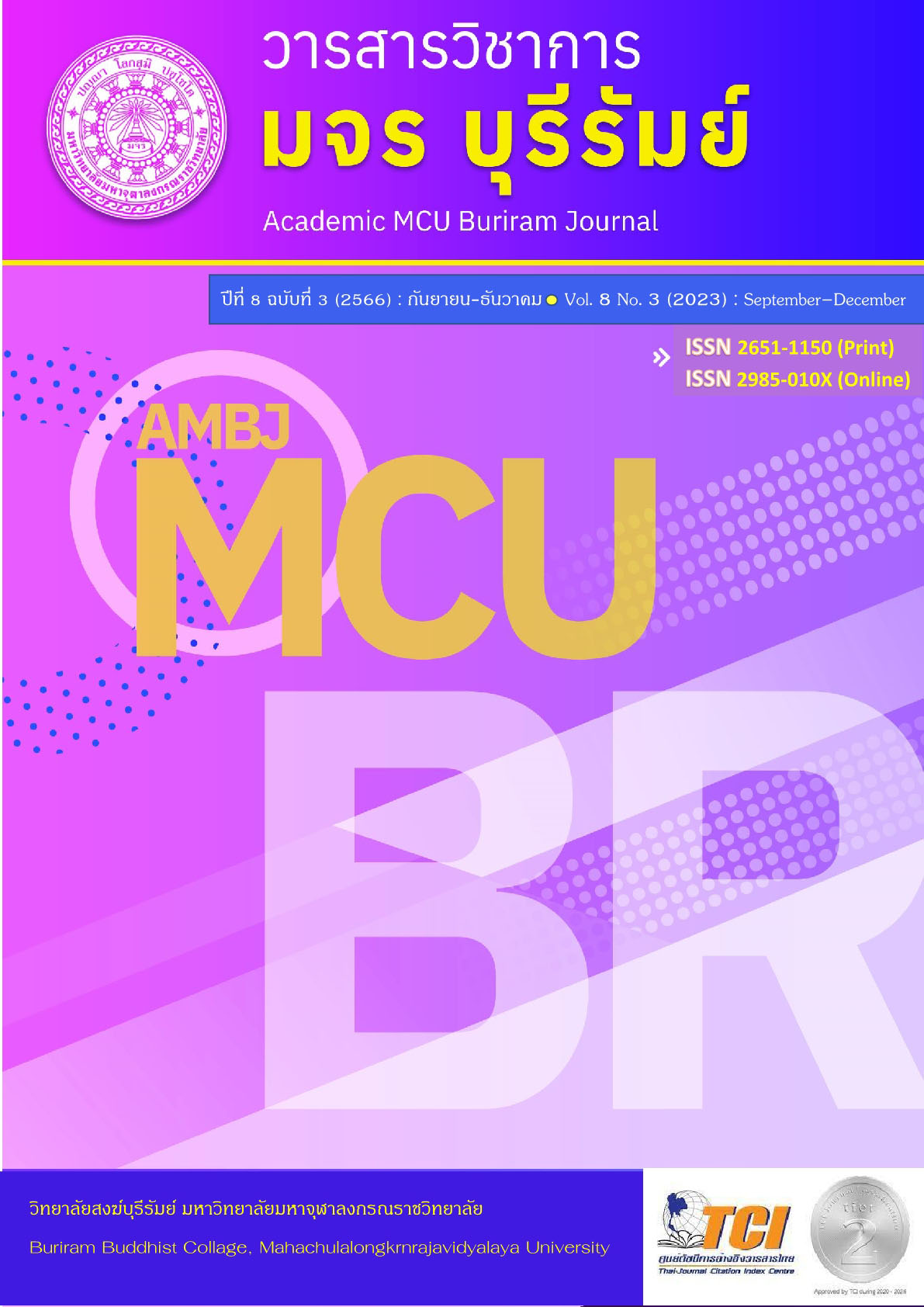Development of Analytical Thinking Ability in Fun Stories for Grade 1 Students using Questions based on Bloom's Revised Taxonomy
Keywords:
Analytical Thinking Ability, Question Based on Bloom's Revised TaxonomyAbstract
The purposes of this research were: 1) to compare the analytical thinking ability of Grade 1 students in fun stories before and after using Questions based on Bloom's Revised Taxonomy 2) to compare the analytical thinking ability of Grade 1 students after using Questions based on Bloom's Revised Taxonomy with the 60 percent criterion. The sample was cluster randomly assigned to a group of 15 students of Grade 1 students in Ban Si Phum Samakkhi School, Krasang District, Buriram Province in the first semester of 2023 academic year. The instruments were the 3 lessons and the achievement test (reliability = 0.76). The statistical procedures used for data analysis were arithmetic mean, percentage, standard deviation, the normal curve distribution was also tested. the test, therefore, was performed using t-test dependent group and one-sample.
The research results found that:
1. The average score of analytical thinking ability of grade 1 students in fun stories after learning using Questions based on Bloom's Revised Taxonomy was significantly higher than the one before learning at the .05 level of significance.
2. The average score of the analytical thinking ability of grade 1 students in fun stories after learning using Questions based on Bloom's Revised Taxonomy, in term of percentage was 71.66 which was significantly higher than the 60 percent of the criterion at the .05 level of significance.
References
เกริก ยุ้นพันธ์. (2543). การเล่านิทาน. พิมพ์ครั้งที่ 3. กรุงเทพฯ: สุวีริยาสาส์น.
ทิพย์เกสร กำปนาท และคณะ. (2563). พฤติกรรมการเรียนรู้ด้านพุทธิพิสัยตามแนวคิดของบลูมที่ปรับใหม่. วารสารบัณฑิตวิจัย Journal of Graduate Research, 11(2), 1-9.
บุญชม ศรีสะอาด. (2560). การวิจัยเบื้องต้น. พิมพ์ครั้งที่ 10. กรุงเทพฯ: สุวีริยาสาส์น.
ประพันธ์ศิริ สุเสารัจ. (2556). การพัฒนาการคิด. พิมพ์ครั้งที่ 5. กรุงเทพฯ: 9119 เทคนิค พรินต์ติง.
พัฒร ลอยเด่น. (2564). การศึกษาผลการจัดการเรียนรู้ด้วยโมเดลซิปปาร่วมกับเทคนิคการใช้คำถามที่มีต่อความสามารถในการคิดวิเคราะห์และผลสัมฤทธิ์ทางการเรียนวิชาภาษาไทยของนักเรียนชั้นมัธยมศึกษาปีที่ 6. วิทยานิพนธ์ปริญญาครุศาสตรมหาบัณฑิต. บัณฑิตวิทยาลัย: มหาวิทยาลัยราชภัฏนครสวรรค์.
รุ่งนภา วังโย. (2565). ผลการจัดการเรียนรู้แบบสืบเสาะหาความรู้ 7E ร่วมกับการใช้คำถามตามแนวคิดของบลูมที่ส่งผลต่อผลสัมฤทธิ์ทางการเรียนวิชาภาษาไทยของนักเรียน ชั้นประถมศึกษาปีที่ 5. วิทยานิพนธ์ปริญญาครุศาสตรมหาบัณฑิต. บัณฑิตวิทยาลัย: มหาวิทยาลัยราชภัฏวไลยอลงกรณ์.
โรงเรียนบ้านศรีภูมิสามัคคี ฝ่ายบริหารงานวิชาการ. (2564). รายงานผลการทดสอบการประเมินความสามารถในการอ่าน (Reading Test: RT) นักเรียนชั้นประถมศึกษาปีที่ 1 ปีการศึกษา 2564. บุรีรัมย์: โรงเรียนบ้านศรีภูมิสามัคคี.
วันเพ็ญ กลิ่นอ่อน. (2559). ได้ศึกษาการพัฒนาความสามารถในการคิดวิเคราะห์ของนักเรียนชั้นมัธยมศึกษาปีที่ 1 โดยใช้รูปแบบการจัดการเรียนรู้แบบซิปปา ร่วมกับเทคนิคการใช้คําถาม. วิทยานิพนธ์ปริญญาครุศาสตรมหาบัณฑิต. บัณฑิตวิทยาลัย: มหาวิทยาลัยราชภัฏนครปฐม.
วาสนา อามาตย์. (2557). การพัฒนาการจัดกิจกรรมการเรียนรู้การอ่านจับใจความ โดยการใช้คำถามตามแนวคิดของบลูม (Bloom) กลุ่มสาระการเรียนรู้ภาษาไทย ชั้นประถมศึกษาปีที่ 6. วิทยานิพนธ์ปริญญาครุศาสตรมหาบัณฑิต. บัณฑิตวิทยาลัย: มหาวิทยาลัยราชภัฏมหาสารคาม.
สุปรียา บุบผามะตะนัง. (2560). การพัฒนาการอ่านจับใจความ กลุ่มสาระการเรียนรู้ภาษาไทย ของนักเรียนชั้นมัธยมศึกษาปีที่ 1 โดยใช้คำถามตามแนวคิดของบลูม. วิทยานิพนธ์ปริญญาครุศาสตรมหาบัณฑิต. บัณฑิตวิทยาลัย: มหาวิทยาลัยราชภัฏมหาสารคาม.
สุทธิ ศรีชล. (2552). การสอนทักษะการอ่านภาษาอังกฤษ. กรุงเทพฯ: โรงพิมพ์คุรุสภาลาดพร้าว.
อมรา ประสิทธิ์รัฐสินธุ์. (2548). ภาษาในสังคมไทย : ความหลากหลาย การเปลี่ยนแปลง และการพัฒนา. พิมพ์ครั้งที่ 4. กรุงเทพฯ: โรงพิมพ์แห่งจุฬาลงกรณ์มหาวิทยาลัย.
อรุณี วิริยะจิตรา. (2555). เหลียวหลังแลหน้า การสอนภาษาอังกฤษ. กรุงเทพฯ: หน้าต่างสู่โลกกว้าง.
อวยพร พานิช และคณะ. (2553). ภาษาและหลักการเขียนเพื่อการสื่อสาร. พิมพ์ครั้งที่ 6. กรุงเทพฯ: สำนักพิมพ์แห่งจุฬาลงกรณ์มหาวิทยาลัย.
Anderson, L. W., & Krathwohl, D. R. (2001). A taxonomy for learning, teaching, and assessing: A revision of Bloom’s taxonomy of educational objectives. New York: Addison Wesley Longman.
Geniusschool thailand. (2565). 3R x 8C ทักษะที่นักเรียนต้องมีในศตวรรษที่ 21. เข้าถึงได้จาก https://geniusschoolthailand.com/3r-x-8c (สืบค้นเมื่อ 26 กันยายน 2565).
Downloads
Published
How to Cite
Issue
Section
License
Copyright (c) 2023 Academic MCU Buriram Journal

This work is licensed under a Creative Commons Attribution-NonCommercial-NoDerivatives 4.0 International License.
ทัศนะและความคิดเห็นที่ปรากฏในบทความวารสารฉบับนี้ถือเป็นความรับผิดชอบของผู้เขียนบทความนั้น ไม่ถือเป็นทัศนะและความรับผิดชอบของบรรณาธิการ





